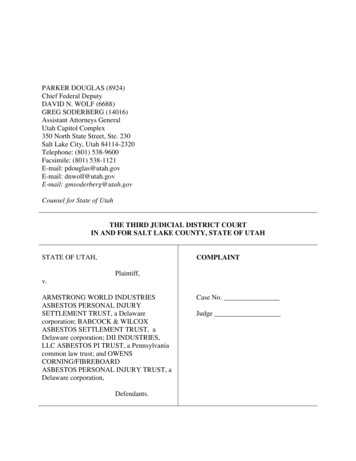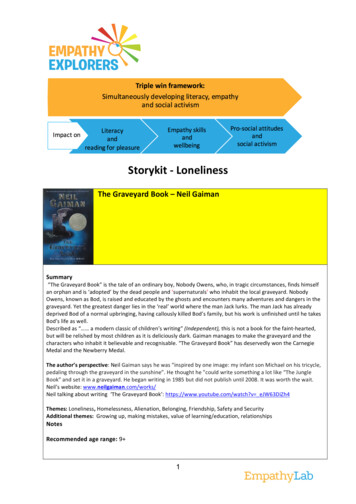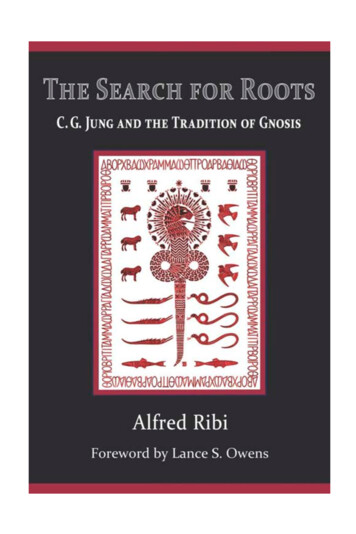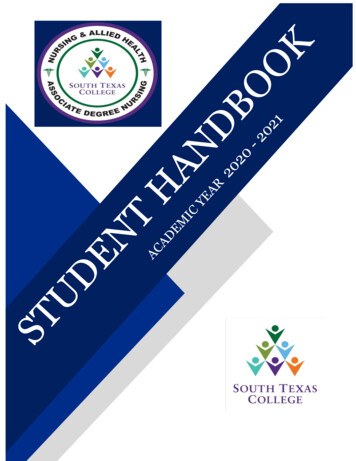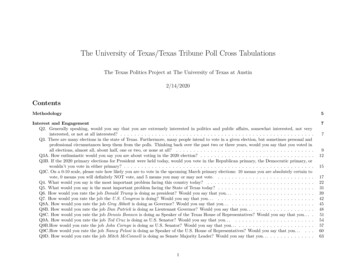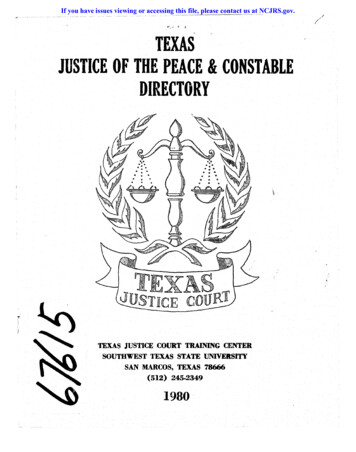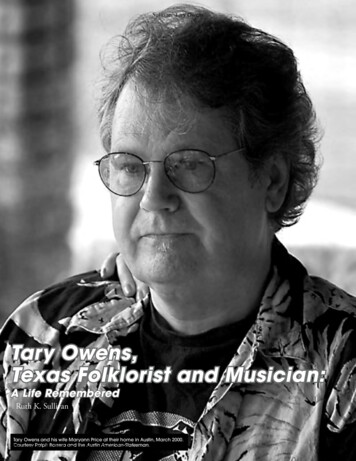
Transcription
Sullivan: Tary OwensTary Owens,Texas Folklorist and Musician:A Life RememberedRuth K. SullivanTary Owens and his wife Maryann Price at their home in Austin, March 2000.Courtesy RalphBarreraandElectronicthe Austin American-Statesman.Producedby TheBerkeleyPress, 20091
Journal of Texas Music History, Vol. 9 [2009], Iss. 1, Art. 3Tary Owens, Texas Folklorist and Musician:A Life RememberedShortly after the death of Austinbased musician and folkloristTary Owens on September 21, 2003,Brad Buchholz, writing for the AustinAmerican-Statesman, remarkedthat, “Tary Owens devoted most ofhis life to music, though only rarelyto his own. The greater mission,to Owens, was to champion themusic of forgotten or unsung Texasbluesmen—to put their songs onrecords, to place them on a stage,to encourage a larger public tocelebrate their artistry.”1Owens began that mission in the 1960s, when he attended theUniversity of Texas at Austin and studied with noted folkloristsAmérico Paredes and Roger Abrahams. Funded by a LomaxFoundation grant, Owens traveled around Texas recording avariety of folk musicians, including guitarists Mance Lipscomb,Freddie King, and Bill Neely, as well as barrelhouse pianoplayers Robert Shaw and Roosevelt T. Williams, also knownas the “Grey Ghost.” Owens remained involved in the lives ofthese musicians for the next several decades and, in some cases,was largely responsible for helping rescue them from obscurityand resurrect their professional careers.Tary Owens worked with a number of other important Texasartists throughout his life, including Townes Van Zandt, GuyClark, Kris Kristofferson, Johnny and Edgar Winter, and JanisJoplin, whom he befriended in high school in Port Arthur andremained close to until her death in 1970. Although Owens wasa musician himself, he devoted most of his time and energy topreserving and promoting the music and the careers of others.Fortunately, because of his efforts to document a wide range ofstyles found throughout Texas, Owens has helped provide allof us with a much more complete understanding of the uniqueand complex musical heritage of the Lone Star State.Tary Kelly Owens was born in Toledo, Ohio, on November 6,1942, less than one year after the United States entered WorldWar II. Shortly after Tary’s birth, his father, Louis Owens, afarm boy from East Texas, was drafted into the U.S. Army andwent to Georgia for basic training. Mary Charlotte Owens tookher infant son and spent the next three years living in a varietyof locales, beginning in Georgia close to the army post whereLouis trained. After her husband shipped out to fight in thePacific, Mary moved back and forth from Ohio to /392
Tary Owens, Texas Folklorist and Musician:A Life RememberedSullivan: Tary OwensMy Texas grandfather played every stringedinstrument there was and could also play organ,piano, and he had a mandocello, which is a prettyrare stringed instrument He’d been a dance hallfiddler in the area of Athens and Murchison in EastTexas. And apparently his father [also was a fiddleplayer] the fiddling had been passed down forseveral generations of Owenses. They were fiddlers inNorth Carolina and Alabama and Texas And oneof my uncles played in the Light Crust Doughboys.310A young Tary OwensIllinois to live with her parents, Helen and John Kelly, thento Texas to stay with the Owens Family, and eventually backto Ohio. Before Louis’s discharge from the service in 1946,Mary took Tary on train trips to visit his father at a variety ofarmy bases where he was posted. These train rides form someof Owens’s earliest memories and helped shape the direction ofhis adult life:When I was first exposed to music, it was big bandmusic on trains, riding trains during World War II,following my father around to various army bases It seemed like every train had a band on it at thetime. And I’d sing with the band, stuff like, “Crossthe Alley from the Alamo” my parents knewI loved singing and they got me enrolled when Iwas about three years old in a dancing and singingschool in Toledo, Ohio.2While his parents loved music, neither of them actuallyplayed a musical instrument. Both grandfathers, however, wereaccomplished musicians. Owens related the story of his family’smusical heritage:Produced by The Berkeley Electronic Press, 2009As a teenager, Owens discovered rock and roll. Hearing ChuckBerry on the radio singing “Maybellene” fascinated Owens. “I’dnever heard anything like that before, and it just took my totalattention.”4 However, it was Elvis Presley who had the biggestimpact on Owens, as well as millions of other white teenagers, byblending together traditional “Anglo” music, especially country,with African-American musical styles. As music historian JoeSpecht describes it, “Many white teens were already in tunewith the rhythm and blues sounds that were in the air, but Elviseffortlessly mixed white hillbilly or country music with blackR&B like no one before.” Presley’s style of music influencedmany other performers, including Texas musicians and futureRock and Roll Hall of Famers Buddy Holly and Roy Orbison.As it turns out, Texas also had an important impact on Presley’scareer. During 1955, he made two hundred appearances infifteen states, and, “At least eighty of these, or almost 40%, werein Texas.” The tremendous popularity Presley gained in theLone Star State at the beginning of his career helped propel himinto the national spotlight. As Elvis himself later said, “’I sortagot my start in Texas.’”5In 1956, when Tary was only fourteen, the Owens Familymoved to Beaumont, Texas. During World War II, Beaumont’scrucial role in the booming Gulf Coast petrochemical industryhad led to rapid population growth, as Americans from a varietyof racial, ethnic, social, and cultural backgrounds flocked to theregion. By the 1950s, Beaumont, along with the neighboringcities of Orange and Port Arthur, formed an area known asthe “Golden Triangle” of the Upper Texas Gulf Coast.6 Theunique combination of ethnic and cultural influences foundin the Golden Triangle helped foster a complex and colorfulmusical environment, which would have a profound effect onTary Owens and others of his generation, including Port Arthurnative, Janis Joplin.7As rich and diverse as the entire state’s musical cultureis, the Golden Triangle, where Tary and his family settled, isparticularly eclectic. This area has been fertile ground forimportant developments in blues, country, Cajun, zydeco, rock3
Journal of Texas Music History, Vol. 9 [2009], Iss. 1, Art. 3and roll, and many other genres. Although the eclectic ethnicmakeup of the local community allowed Owens to broaden hismusical horizons, the tumultuous racial dynamics of the Southduring the late 1950s also proved difficult for him to deal with.As he would later state:In some ways coming to Texas was a movebackward because we were right in the middleof the integration issue. I had gone to school inthe North with black kids, not many, but therewere one or two in most of the classes that I wasin. And I didn’t think much of it. But we got toBeaumont and I rode the bus to school, and everystreet corner by the bus stands there would be blackwomen, middle-aged black women wearing starchedwhite outfits as maids or cooks. And they would bestanding waiting for the bus and all the kids wouldbe screaming obscenities at them out the window ofthe bus. It was just horrible.8Owens was shocked by this kind of blatant racial prejudiceand felt alienated from his peers. Although Louis Owens hadbeen raised in Texas, Tary observed that “my father didn’t haveTary Owens, Texas Folklorist and Musician:A Life Rememberedknew he wasn’t black, but all the music he playedwas “black” music Of course, I loved it.11While living in Beaumont, Owens also met future blues guitarlegend Johnny Winter and his brother Edgar, who had theirown radio show on Saturday afternoons. According to Owens,the Winters were a “teenage kind of Everly Brothers band” andcalled themselves “Johnny and the Jammers.” The three oftenhad long, earnest discussions about blues music and R&B.12In 1957, the Owens Family moved to Port Arthur, seventeenmiles south of Beaumont. Port Arthur was largely a workingclass community, in which nearly everyone’s livelihood dependedin one way or another on the oil refineries and petrochemicalplants. As Owens observed, “Port Arthur was a rough town. Ifyou went to school there, you were going to be challenged.”13For Owens, surviving in such surroundings required that hequickly find his own circle of like-minded friends. In September1957, he enrolled at Thomas Jefferson High School, where heand a small group of classmates developed a bond that wouldlast for the remainder of his life. His deep passion and wideranging appreciation for music practically guaranteed thatOwens’s cadre of friends also would be music enthusiasts. Onesuch pal was Janis Joplin, who would become what some have11When I was first exposed to music, it was big band music on trains,riding trains during World War II, following my father around to variousarmy bases It seemed like every train had a band on it at the time.an ounce of prejudice in him, and neither did my mother. Ijust hadn’t been exposed to that intolerance and hatred andhostility.”9Despite having to grapple with the unfamiliar socialenvironment in which he found himself, Owens did benefitfrom the diverse and prolific music scene around him. Helistened to local radio and attended concerts by a variety ofregional and national groups that performed in the Beaumontarea. J.P. Richardson, later known as “The Big Bopper,” wasborn in nearby Sabine Pass in 1932, and started his musicalcareer as a disc jockey on Beaumont radio station KTRM.10Years later, Owens acknowledged the impact that Richardsonhad on him:‘The Big Bopper,’ J.P. Richardson, who at that timestill hadn’t recorded any songs of his own was theafternoon, drive-time, school-time, 4-7 PM discjockey and he mimicked a black man. Most called “the best white blues singer in American history” and “thegreatest female singer in the history of rock ‘n’ roll.”14 AlthoughJoplin’s meteoric rise to superstardom later separated her frommany of her Texas friends, she and Tary stayed in contact untilher death in 1970.During his first year at Jefferson High, Owens and Joplinwere in a social studies class together. He remembered that oneof the topics which generated heated debate in the class was “theissue of integration and the issue of race, and Janis and I werethe two ‘nigger lovers’ in the class. We started getting called thatby the other kids She and I became friends during that time;we were allies in the social studies class.”15 Soon Owens andhis friends discovered Jack Kerouac’s novel On the Road, whichfired their imaginations and made them long to be part of the“beat generation”:[We] wanted to be beatniks, but were just tooyoung. I couldn’t even grow a beard. We read books,4
Tary Owens, Texas Folklorist and Musician:A Life RememberedSullivan: Tary Owenswhich was verboten in Port Arthur. And we werestarting to listen to jazz, because by 1958, as far asI was concerned, rock and roll was over with. TheBig Bopper, Buddy Holly, and [Ritchie] Valens werekilled. Elvis got sent to the army The rebellion partof rock and roll ended, and rock and roll was cleanedup, sanitized, and sounded like crap. So we startedlistening more and more to the black music. And thatmeant blues and jazz I love them both equally. 16In addition to Janis Joplin, some of Tary Owens’s other closestfriends included Jim Langdon and Jack Smith. Langdon playedtrombone in the school band and also performed with local R&Band rock and roll bands.17 Jack Smith also was passionate aboutmusic, and Owens, Joplin, Langdon, and Smith frequentedNone of us played anything but we all sang Janiswas just influenced by any female blues singer—BigMama [Thornton] was one of the ones, but she wasprobably more influenced by Bessie Smith Herfirst singing was at a jazz jam session in Beaumontthat we went to where Jim Langdon was playing It was basically a band of black jazz musicians whoplayed R&B too and on Sundays they got togetherfor jam sessions And she got up and sang two BessieSmith songs and got a really good response.20After graduating from Jefferson High in 1960, Owens startedcollege at Lamar Tech (Lamar Institute of Technology) inBeaumont. Janis Joplin also enrolled at Lamar Tech, but as Taryadmits, “None of us were very good students.” It was at LamarWe were starting to listen to jazz, because by 1958,as far as I was concerned, rock and roll was over with.12the many honky tonks and juke joints scattered along the backroads throughout the Texas-Louisiana border region.18 Owensdescribed their visits to the nearby night clubs:That’s where we all grew up in a place calledThe Big Oaks Club; another one called LuAnn’s;another called Buster’s; another called the ShadyGrove Buster’s had country music. Luann’s andthe State Line had black R&B, rock and roll, andthe Big Oaks had white bands doing rhythm andblues. And Jim Langdon was in those white bigbands; also Johnny Winter—that’s when I gotreacquainted with Johnny. He was in this band thatwas called Jerry and the Counts. And the wholething was being able to sound black. There [wouldbe a singer who] could sing like Bobby Bland or RayCharles Lots of horns and they always openedwith jazz, playing jazz. That was a musical formatthat I haven’t found since I left there.19By the late 1950s, Owens and his friends had turned increasinglyaway from rock and roll and were devoting their attention almostentirely to more traditional folk, blues, and R&B:We were listening to Leadbelly, Odetta; you knowthe folk revival of the 60s was coming on. Andthat was when Janis learned that she could sing—bysinging Leadbelly and Odetta songs at our parties Produced by The Berkeley Electronic Press, 2009Tech that Owens enrolled in an English course about folklore.His research into folklore, and particularly folk ballads, piquedhis interest in exploring and documenting folk music from anacademic perspective. By 1962, Owens had decided to move toAustin and enroll at the University of Texas in order to studyfolk music.21During the early 1960s, Austin was, in many ways, still atypical “college town,” enhanced by the population of studentsfrom all over Texas, the United States, and the world. Life onthe University of Texas campus generally revolved around coursework, extracurricular activities, and for some students, a sociallife centered on sororities and fraternities. However, challenges tothese established traditions were already fomenting in Austin whenTary Owens arrived in 1962. It was earlier that summer, while hewas still living in Beaumont, that Owens had met John Clay andBill Beckman, both University of Texas students. They invitedTary to Austin to visit them at their apartment complex nearcampus, known affectionately as “the Ghetto.” Owens recalledsome of the people he met there and the music he heard:That weekend I heard Powell [St. John] and Lannie[Wiggins] play and was very impressed. Lannie hada Martin 017 and a banjo. He played both verywell, finger picking and flat picking on the guitar.On banjo he could frail “old timey” style as wellas three finger “Scruggs” style picking. He seemedto know all of Woody Guthrie’s songs, as well astraditional ones like “Railroad Bill.” Also, jug band5
Journal of Texas Music History, Vol. 9 [2009], Iss. 1, Art. 3tunes like the Memphis Jug Band’s “Stealin’” andLeadbelly’s “Goin’ Up That Mississippi River.” I hadnever heard anyone play traditional music so well.Lannie had a huge influence on me and I vowedto learn to play like him John and Powell werethe first hipster songwriters [in Austin] who wrotetraditional style. 22Later in the summer, Owens left the Beaumont-Port Arthurarea for good and moved to Austin to join his new friends atthe Ghetto, a few blocks from the university. While he arrivedwith few college credits, his interest in folklore had grownsubstantially because of the English courses he had taken atLamar Tech:I first got interested in folk music before I came toAustin I was taking an English course from Dr.Frank Abernathy at Lamar Tech in Beaumont hehad been an officer in the Folklore Society and was a folklore nut. I ended up taking my freshmanEnglish from him. We talked about folk music—collecting folk music, finding it and the people thatwere doing the old songs.23The Ghetto soon became a hotbed of musical activity for Owensand his friends. As University of Texas art major, Powell St. John,a long-time Ghetto resident and harmonica player recalls:By this time (the summer of 1962), I was heavilyinvolved in the folk music revival that was ourgeneration’s version of goldfish swallowing andraccoon coats. Janis Joplin was a frequent visitorto the Ghetto, and she and Lannie Wiggins, a hotguitar and banjo picker and I had worked up a setof material and were having great fun picking andsinging and drinking beer every night in the backyard. Tary and Langdon were jazz fans. Langdonwas an accomplished trombone player and Tarywas on the scene and now he was playing guitar Iguess, getting into the music that was really hip atthe time.24Owens, and some other Ghetto residents took part regularlyin the Thursday night “folksings” at the university’s StudentUnion building. These were open to anyone who wanted tosing and play or just listen. Author Barry Shank, who discussesthe development of 1960s Austin music in his book, DissonantIdentities, suggests that the students who participated inthese weekly folksings were looking for ways to differentiatethemselves “from the student body represented by /iss1/3Tary Owens, Texas Folklorist and Musician:A Life Rememberedsororities, and football players.” The Ghetto crowd, includingOwens, Joplin, and the others “latched onto the singing oftraditional folk songs as a way of actively demonstrating theirdifference—their ‘beatnik’ or ‘proto-hippie’ status.”25 Owensremembered these gatherings with his friends and described thefolksings as the forerunner of the folk music scene in Austin:All sorts of people would come to the folksing We started the organization for traditional music—that’s what we called it; we didn’t use the wordfolk. We started putting on concerts in the Union,not the ballroom, the Union Theater, at the northend of the building; there was a movie theater andauditorium. It’s still there Michael Nesmith, fromSan Antonio (later a member of the pop group,The Monkees) well he had a trio, a folk trio thatimitated the Kingston Trio. He brought his trioup to Austin to play at the folksing. I think theywere expecting to bowl everybody over; we werenot Kingston Trio fans at all. As far as we wereconcerned, that was old history. They were not wellreceived.2613Soon, Owens and others from the folksings, most specificallythe Ghetto crowd, found out about another gathering ofmusicians and singers every Wednesday night at KennethThreadgill’s bar on North Lamar Boulevard in Austin. Owensand his friends heard that Threadgill could sing like JimmieRodgers and had a jukebox filled with records by Rodgers andHank Williams.27By the time Owens and his friends discovered Threadgill’s, itwas a well-established destination for a diverse group of musicpatrons. In some ways, Kenneth Threadgill’s personal history issimilar to that of Owens. Threadgill was born on September 12,1909, in Peniel, Texas, northeast of Dallas. His family eventuallymoved to Beaumont, however, and as a young man, Threadgillworked at the Tivoli Theater where Jimmie Rodgers, the manlater dubbed the “Father of Country Music,” performed. Theyoung Threadgill, who had practiced imitating Rodgers’sdistinctive singing and yodeling style, was able to meet his idolbackstage and impressed him with his own yodeling skills.In 1933, Threadgill moved to Austin and began working atan old service station located at 6416 North Lamar Boulevard.In December of that same year, he bought the place andconverted it into a tavern with a restaurant, gas station, andan area in which he and other performers could sing and play.Taking advantage of the recent repeal of Prohibition, Threadgillapplied for and received the first beer license in Austin. Heand his wife, Mildred, ran the venue for the next four decades,closing only for a brief time during World War II. Although6
Tary Owens, Texas Folklorist and Musician:A Life RememberedSullivan: Tary Owens14Kenneth Threadgill and the Hootenanny Hoots, 1971. Courtesy Burton Wilson.the club could seat only about forty-five customers, the placewas usually packed on weekends when Threadgill and his band,the Hootenanny Hoots, played. Wednesday nights became thedesignated time “for university students and local residents tocongregate for beer, country music, yodeling, and the ‘AlabamaJubilee,’ the song that would usually get Threadgill to dance hispatented shuffle.” Those Wednesday night gatherings attracteda diverse group made up of “goat ropers, university Greeks,hippies, and average Joes,” who mixed together to enjoy themusic and camaraderie.28Other students from the University of Texas had discoveredThreadgill’s around 1959 and had become regular performersat the Wednesday night gatherings. Among these older studentswas Bill Malone, whose dissertation on the history of countrymusic would evolve into the groundbreaking book, CountryMusic U.S.A., which is still considered by many historians tobe the most comprehensive scholarly study of country music.Others included Stan Alexander, an English graduate studentwho studied traditional folk songs and ballads, Willie Benson,a psychology major and bluegrass guitarist, and Ed Mellon,who played mandolin in the style of Bill Monroe, the so-calledProduced by The Berkeley Electronic Press, 2009“Father” of bluegrass. Malone, Alexander, Benson, and Mellonhad been playing weekly at Threadgill’s for years before Owensand his friends first visited the establishment.29Meanwhile, back at the Ghetto, Powell St. John on harmonica,Lannie Wiggins on guitar and banjo, and Janis Joplin on autoharp and vocals, had started performing together as the WallerCreek Boys. Along with Owens and others, they began goingto Threadgill’s to take part in the Wednesday night musicgatherings. As Owens recalled, “Kenneth [Threadgill] notonly welcomed all of us and treated us like his children, [but]encouraged us to play.”30 Owens agreed that these Wednesdaynight performances attracted a diverse group of patrons. “TheThreadgill’s music scene was like a coming together of therednecks and, they weren’t hippies yet, the pre-hippie hipsters, Iguess. All three places were our scene Threadgill’s, the Ghetto,and the folksing.”31Though not yet a student in 1962, Tary Owens often hungout on campus at the “Chuck Wagon” and attended the folksingsin the Student Union, where he befriended a variety of students,including Gilbert Shelton, Tony Bell, Lieuen Adkins, and BillHelmer, who were on the staff of The Texas Ranger, the campus7
Journal of Texas Music History, Vol. 9 [2009], Iss. 1, Art. 3humor magazine. Owens also met his first wife, MadeleinePeppel (now Villatoro) at the Chuck Wagon before he enrolledas a student. Madeleine recounted those college days:My mother had wanted me to be in a sorority. Iwas very shy and [that was] not my thing at all Ihad gotten out of the sorority and there was a wholegroup of people that were meeting in the ChuckWagon that’s where I first met Tary And that’swhere there were a lot of young people who werecounter-culture they were outsiders in a way [Tary] was writing some poetry. I don’t know that hewas actually writing songs. He was already familiar,I guess, because of Janis’s interest in Appalachianmusic, folk music, and ballads that’s the kind ofold ballads [that]Tary would sing I got pregnantvery soon after we got to know each other [in 1963].Our son [Willie] was born in April of 1964 oncewe were married and he was taking the courses wewere spending all of our money on records. He wasaccumulating all the music the blues. He was reallygetting into that; buying a lot of the blues music. 32Owens formally enrolled at the University of Texas in 1963.He knew that he loved Madeleine and believed that he should getmarried and go back to school in order to support his new family:[I decided] I’ll go back to school and get a real joband quit this beatnik life. I never quit the beatniklife, but I did get a job at the Austin State Hospitalas an attendant that’s what they called the peoplewho took care of the mentally ill I worked on the11 to 7 shift at night I worked there for three yearswhile I enrolled, got myself back into UT. I went tosummer school one summer to get my grades up and once I got in, I went straight through for thenext three years. [I] worked at the state hospitaland participated in the Threadgill’s band everyWednesday night and participated in the growingunderground scene that grew out of the Ghetto.33Drugs became an important part of the counter-culturemovement in Austin and elsewhere throughout America duringthe 1960s. Because many of them were using illegal drugs, Owensand his friends knew that the Ghetto was under police surveillanceand that they all faced the possibility of being arrested. Owenscommented on the widespread use of drugs at the Ghetto:We smoked pot, but it was hard to get. You had togo over to the east side and buy if from black ry Owens, Texas Folklorist and Musician:A Life Rememberedmusicians. Even best friends at the Ghetto wouldnot tell each other that they smoked pot. Everyonewas that paranoid about it. They were doing itprivately, but we did start peyote there. Peyote, atthe time, was legal. You could get peyote buttons atthe Hudson’s Cactus Farm in Leander for a nickela bud My first trip to Austin I took peyote. Thatbecame part of everyone’s experience And it wasa very spiritual experience; it was very intense. [InBeaumont] well, we smoked grass; I had my firstgrass—I got it from Janis. She got it in Mexico, ona trip to Mexico. There were a lot of drugs around[Beaumont], but we weren’t part of the drug scenethere, except for smoking pot Not very much potat all. The drugs started in Austin.34Owens moved out of the Ghetto in 1963 and into a house on32nd Street, right across from Burton Wilson, a well-known Austinphotographer. When Madeleine Peppet first met Owens, he wasliving there, but after the marriage, they moved to a new location:We lived by the campus; it was 22nd and PearlStreet an old stucco, two-story building that hadapartments it cost like 50 a month. And downthe hall was Tommy Hall And next door wasGilbert Shelton, Tony Bell, and they were doingthe Ranger humor magazine. And, Gilbert had apiano there, and I can remember that Maria Muldarcame, at one time, and played there. They had aparty, and she played.3515Once Owens enrolled at the University of Texas, he registeredfor classes in folklore taught within the English department byDrs. Américo Paredes and Roger Abrahams. The Universityalready had a strong tradition of folklore scholarship establishedby such celebrated faculty members as J. Frank Dobie and JohnHenry Faulk. The fact that Paredes had recorded MexicanAmerican folk music during the 1950s, and Abrahams had a1961 recording on the Prestige label, impressed Owens andinspired him to follow in their footsteps.37The first folklore class Owens took was an introductory coursetaught by Paredes. The students’ first assignment was to find aselection of folklore, bring it to class for discussion, and thenwrite a paper about it. Owens used material he had found earlierduring his class with Dr. Frank Abernathy at Lamar Tech:That was the first folklore I had collected. I’dlistened to an East Texas man singing, “Black-JackDavid” which is one of the oldest ballads goingback to England and France. It used to be the “Raggle,8
Tary Owens, Texas Folklorist and Musician:A Life RememberedSullivan: Tary OwensTaggey Gypsies, Oh,” and “Gypsy Davey” and lotsof different variances the East Texas version of itwas “Black-Jack David.” [This song] is one of theChilde [ballads] and very well documented verypopular in England and Ireland.3816Paredes was quite taken with the song, and he was impressedby Owens’s writing and his keen interest in the whole process offolklore. Owens found Paredes to be a superb teacher and mentor,as well as someone with his own fascinating story, who had beena folklore “subject” before he became a scholar and educator. 39Born in Brownsville, Texas on September 3, 1915, AméricoParedes experienced first-hand the border tensions and violencethat followed the 1910 Mexican Revolution, as well as theethnic bias and discrimination aimed at Mexican Americans. Heattended public schools, worked a variety of jobs to help supporthis family, and during summer vacations often took ranch jobsand “listened to corridos, folk tales, and oral traditions recountedby border ‘Mexicanos’ around the campfire.” All of these wereinfluences he would eventually incorporate into his own poetryand prose. Along the way he also learned to play guitar and sing.After graduation from high school in 1934, Paredes enrolledat Brownsville Junior College, worked for the BrownsvilleHerald as a staff writer, and submitted his poetry to La Prensa,a San Antonio newspaper. His first book of poetry, Cantos deAdolescencia, was published in 1936. Paredes continued writingfor the Herald, and he worked for Pan American Airways priorto his enlistment as a U. S. Army infantryman in 1944.40During the 1940s, Paredes met Texas folklorist and authorWilliam A. Owens, who was traveling throughout the statecollecting regional folk songs as part of his job with the ExtensionDivision of the University of Texas. Ow
celebrate their artistry." 1 . Owens began that mission in the 1960s, when he attended the University of Texas at Austin and studied with noted folklorists Américo Paredes and Roger Abrahams. Funded by a Lomax Foundation grant, Owens traveled around Texas recording a variety of folk musicians, including guitarists Mance Lipscomb,

